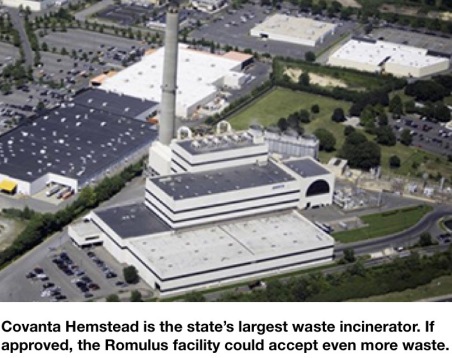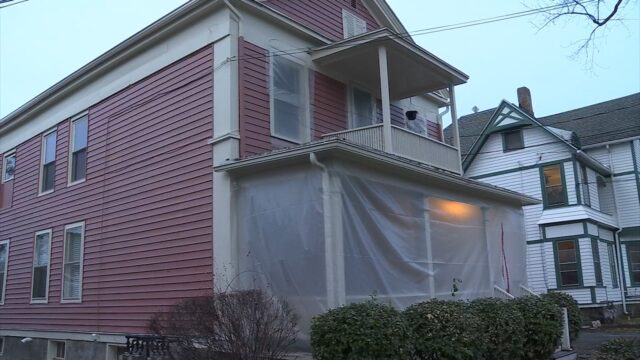Joseph Morelle, Majority Leader of the State Assembly and a candidate for Congress in November, wrote key state officials this week to urge them to deny a permit for a proposed garbage incinerator in Romulus, but project opponents say he could — and should — do far more to kill the project.
Morelle made his case in a Sept. 10 letter to the five members of the state Board on Generation Siting and the Environment, which is expected to consider an application by Circular enerG LLC to build the state’s largest waste-to-energy facility at the former Seneca Army Depot.
Morelle wrote that the company’s plan to import garbage from “hundreds of miles away” and burn it in a plant located between the two largest Finger Lakes would disturb the region’s established agriculture and tourism industries.
But leaders of a region-wide movement to block the project reacted with notable coolness toward the letter.

While they said they “appreciate” the gesture, Seneca Lake Guardian and the Finger Lakes Wine Business Coalition said Morelle must take more decisive action to serve his constituents.

Namely, he should exert his “considerable power” to reconvene the Assembly before yearend to vote on a popular bipartisan bill (A11214) that would halt the project before it even reaches the Siting Board for consideration, they said.
“We hope that Mr. Morelle isn’t simply trying to placate the residents of the Finger Lakes with this letter,” Joseph Campbell, president of Seneca Lake Guardian said in a press release Wednesday. “Actions speak louder than words and his constituents will remember if he continues to remain on the sidelines.”
A spokesperson for Morelle said Friday that the majority leader had expressed to Gov. Andrew Cuomo and Assembly Speaker Carl Heastie his desire for a special session to consider the incinerator bill, among other issues. But his power is limited, said Sean Hart, Morelle’s director of communications.
“Calling the Assembly back to Albany for a special session remains at the sole discretion of the Speaker,” Hart said in an email to WaterFront. “The majority leader will continue to advocate and urge the speaker to do so.”
The bill would bar permits for garbage incinerators within the Finger Lakes watershed. The measure had broad legislative support before it was derailed in the closing hours of the 2018 session. The bill had passed the Senate unanimously and cruised through Assembly committees before Heastie decided not to call it up for a vote.
The explanation given was that the incinerator bill had been held hostage in complex inter-party negotiations over an unrelated bill dealing with cameras that detect speeders in school zones.
Disappointment over the bill’s surprising defeat soon became mingled with suspicion among some incinerator opponents when it was revealed that Morelle and Gov. Andrew Cuomo, in particular, had received significant campaign contributions from a source closely tied to the owner of the proposed plant site. (Cuomo, like Morelle, has said he opposes the incinerator project.)
That property is owned Seneca Depot LLC, a company affiliated with David M. Flaum, one of Cuomo’s largest contributors since 2009.

The real estate company Flaum founded, Flaum Management, shares the same Andrews street address in Rochester as Seneca Depot and Circular enerG. Michael Palumbo, the chief operating officer of Flaum Management, is president of Seneca Depot, and he has been an active supporter of the incinerator project.
Records show Flaum and his wife, Irene Flaum, have contributed more than $150,000 to the governor, including $25,000 last December. Cuomo has their financial support despite that fact that he is a Democrat, while their total political contributions of more than $500,000 in recent years have gone overwhelmingly to Republicans, including President Donald Trump.
Morelle, a Democrat, is another exception to the Flaums’ giving patten.
Two months after Circular enerG was formed in January 2017, Flaum and his wife each contributed $2,500 to Morelle’s re-election campaign to the state Assembly.
After Morelle announced in April that he was running for the 25th District Congressional seat long held by the late Louise Slaughter, Ilene Flaum made a $2,700 contribution, the maximum allowed for the period, to his bid for Congress.
Morelle won a four-way primary for the Democratic nomination in June, and he faces Republican neurosurgeon Jim Maxwell on election day, Nov. 6. A Siena College poll in mid-August showed Morelle leading in the race with 55% to Maxwell’s 31%, with 13% of voters undecided.
William Ouweleen, secretary of the Finger Lakes Wine Coalition, said Morelle must not allow the state Senate-passed incinerator bill to die without an Assembly vote after his expected jump to Congress in November. The Senate’s passage of the bill becomes moot Jan. 1.
“Show us all that you are worthy of a Congressional District, prepared to build on Louise Slaughter’s legacy in Congress, Joe,” said Ouweleen, who knew Morelle and his family growing up. “Show us that you are truly the Assembly Majority Leader through your actions and reconvene the Assembly to address this languishing bill before it is too late.”
Hart, Morelle’s spokesman, said: “Regardless of the outcome in the race to fill the vacancy in NY-25, the Assembly can still reconvene to take up A11214 before the end of the year.
“There is the possibility that if the Majority Leader wins the special election that he would not be able to participate in a vote on the bill – should one take place after November 6. However, that said, there are 149 other members of the Assembly, with only 76 yes votes needed to pass the bill, and the Majority Leader would still take an active role in urging them to support this legislation.”
Asked if Morelle had been in contact with Flaum, Palumbo, Circular enerG principal Gene Zhou or Circular enerG attorney Alan Knauf concerning the incinerator project, Hart said:
“Yes. He has discussed the project with Michael Palumbo. In this conversation, the Majority Leader made clear his opposition to the proposal and strong support of A11214.”
Knauf, the chief spokesman for the incinerator project, did not return a phone call.
Circular enerG has not yet filed its request under Article 10 for a certificate of Environmental Compatibility and Public Need for its project, but is has started the process by drafting and then revising a public involvement plan.
Assuming the company pursues the certificate, the Cuomo Administration’s Siting Board will have the final say. Its five members are: Chairman John B. Rhodes of the state Department of Public Service; Howard A. Zucker, commissioner of the state Department of Health; Richard L. Kauffman, chair of the state Energy Research and Development Authority (NYSERDA); Howard Zemsky, president and CEO of Empire State Development; Basil Seggos, commissioner of the state Department of Environmental Conservation.
Ouweleen, of the Wine Coalition, said the region could avoid the lengthy Article 10 process by simply passing the popular incinerator bill.
“The Article 10 process can be long and drawn out,” he said. “We don’t want to have to litter the region with “No Incinerator” signs for years. Bad for business.”
Ouweleen speculated that Cuomo’s influence could help explain Morelle’s apparent reticence to try to call the Assembly back in to session to vote on the incinerator bill. “Maybe it isn’t Morelle,” he said. “Maybe it’s Cuomo not wanting a legislative solution because he wants the win himself. He could ride in on his horse and save the Finger Lakes.”
The Circular enerG plant would be the largest waste-to-energy plant in the state, despite its claims to the contrary.
Knauf has said that a plant in Hempstead, currently the largest of New York’s 10 garbage incinerators, would remain the state’s biggest. But records show that Hemstead has the capacity to burn 2,505 tons of garbage a day and produce up to 72 megawatts of electric power, while Circular enerG has stated that the Romulus plant would burn up to 2,640 tons per day and produce up to 80 megawatts of power.
Virtually all of the garbage that would be burned at the Finger Lakes site would come from the New York City area, hauled in by up to 200 trucks per day — or fewer, if trains are used.
Last month, Circular enerG and Seneca Depot sued the Town of Romulus and its planning board in a bid to annul a local zoning amendment that prohibits waste-to-energy projects within its jurisdiction.
In that lawsuit and an accompanying memorandum of law, the plaintiffs also ask a Seneca County Supreme Court judge to rule that the zoning amendment is preempted by the Article 10 process supervised by the Siting Board.
In the suit, plaintiffs argue that landfills produce less methane, a potent greenhouse gas, than waste-to-energy facilities. “By eliminating waste-to-energy plants from the town, the town has committed to increase its generation of methane by using landfills to dispose of waste, from both sources inside and outside the town,” the companies argue.
Seneca Lake Guardian has questioned how it is appropriate to hold the town legally responsible for garbage generated outside its borders.
A hearing on the matter is scheduled for Sept. 28.
Peter Mantius is the founder of the Water Front, an all-digital publication dedicated to providing news and coverage of important environmental news in the Finger Lakes. His brings decades of reporting and editorial experience to his work, which includes frequent deep-dives into local, and regional issues. Contact him by clicking here or dropping him a line at [email protected].














